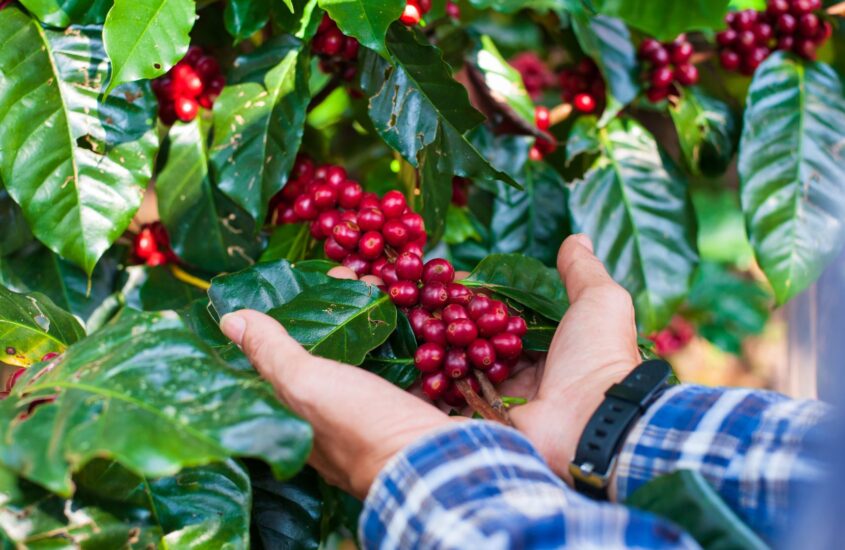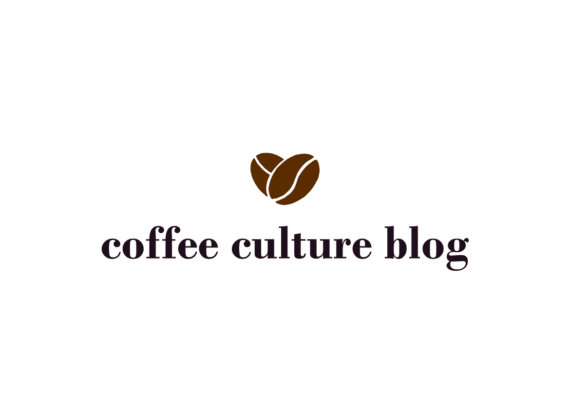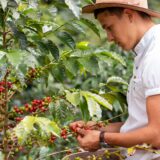How is Non-Organic Coffee Grown: Methods, Impacts, and Facts

Table of Contents
How is Non-Organic Coffee Grown: Methods, Impacts, and Facts
2. Cultivation Methods in Non-Organic Coffee Farming
- Use of Synthetic Chemicals
- Sun Cultivation Practices
- Soil Degradation
- Water Contamination
- Biodiversity Loss
- For Farmers and Workers
- For Consumers
- Cost of Production
- Market Dynamics
6. Comparative Insights: Organic vs. Non-Organic Coffee Farming
Introduction
Have you ever wondered how non-organic coffee is grown?
Non-organic coffee farming focuses on maximizing yield. Farmers use synthetic chemicals and modern practices to boost production. These methods meet high demand but impact the environment, workers, and consumers.
Here’s how it works, what it affects, and what it means for you.
Cultivation Methods in Non-Organic Coffee Farming
Use of Synthetic Chemicals
Non-organic coffee farming depends on chemicals.
Fertilizers speed up growth. Pesticides control insects. Herbicides eliminate weeds.
For example, a farm in Brazil might use nitrogen-based fertilizers to increase yield by 20%. These inputs produce more coffee, but they stay in the soil and water for years.
Sun Cultivation Practices
Inorganic coffee is often grown in the sun.
This means forests are cleared to create open fields. Without trees, plants get more sunlight and grow faster.
Farmers in Vietnam often use this method to produce high volumes of robusta coffee. But the loss of trees affects biodiversity and soil health.
Environmental Impacts of Non-Organic Farming
Soil Degradation
Chemicals change the soil over time.
Fertilizers boost nutrients for a season, but repeated use weakens the soil. Without trees to hold it together, the soil erodes.
A study in Central America showed that sun-grown coffee farms lose 35% more topsoil than shaded ones.
Water Contamination
Rain washes chemicals into nearby streams and rivers.
These chemicals harm fish and disrupt local ecosystems. A report from Colombia found pesticide runoff in rivers near coffee farms, affecting drinking water for communities.
Biodiversity Loss
Forests are home to countless species. When farms replace them, animals and plants lose their habitats.
For example, shade-grown coffee farms in Ethiopia support twice as many bird species as sun-grown ones. Inorganic methods don’t offer the same balance.
Health Implications of Non-Organic Farming
For Farmers and Workers
Workers face daily exposure to chemicals.
Without protective gear, they inhale pesticides and absorb them through their skin. A study in Nicaragua found that coffee farmworkers had higher rates of chronic respiratory illnesses.
For Consumers
You might wonder if chemicals stay in the beans.
Roasting removes most residues, but small amounts can remain. These are usually below regulatory limits. Even so, more people are choosing organic coffee for peace of mind.
To explore how coffee affects your health, read “What Are the Effects of Coffee on the Body?”.
Economic Considerations
Cost of Production
Inorganic farming produces more coffee per acre.
This lowers costs in the short term. However, soil degradation means farmers need more fertilizers each year. Over time, expenses rise.
Market Dynamics
You may notice more organic coffee on store shelves.
Organic farming appeals to consumers who prioritize sustainability. This creates competition for inorganic coffee in the global market. Farmers often weigh short-term profits against long-term demand trends.
Comparative Insights: Organic vs. Non-Organic Coffee Farming
Aspect | Organic Farming | Non-Organic Farming |
Chemicals | None | Synthetic inputs used |
Impact on Soil | Builds fertility | Depletes nutrients |
Habitat | Supports biodiversity | Reduces forest cover |
Yield | Lower | Higher |
You might find organic coffee smoother and less bitter because of its cleaner production process. For more on organic farming’s role in taste, visit “Countries That Produce the Best Coffee.”
FAQ
What is non-organic coffee farming?
It uses synthetic fertilizers and pesticides to grow coffee faster. This method increases yields but impacts the environment and health.
Why is non-organic coffee cheaper?
Non-organic farms produce more coffee per acre. Chemicals help control pests and boost growth, reducing production costs.
Does non-organic coffee harm the environment?
Yes, it contributes to deforestation, soil degradation, and water pollution.
Is it safe to drink non-organic coffee?
Yes, but some prefer organic coffee to avoid trace chemical residues.
Can non-organic coffee become sustainable?
With reduced chemical use and better practices, it can reduce its environmental impact.
More from me
My biggest life changes, latest minds, and my family life.








